Batman: The Complete Series Blu-ray Movie
HomeBatman: The Complete Series Blu-ray Movie 
Limited Edition / Blu-ray + UV Digital CopyWarner Bros. | 1966-1968 | 3 Seasons | 3019 min | Rated TV-G | Nov 11, 2014
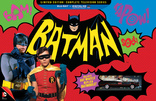
Movie rating
8.1 | / 10 |
Blu-ray rating
| Users | 4.8 | |
| Reviewer | 4.5 | |
| Overall | 4.5 |
Overview
Batman: The Complete Series (1966-1968)
Wealthy entrepreneur Bruce Wayne and his ward Dick Grayson lead a double life: they are actually the crime fighting duo Batman and Robin. A secret Batpole in the Wayne mansion leads to the Batcave, where Police Commissioner Gordon often calls the Bat-duo on the Batphone with the latest emergency threatening Gotham City. Racing to the scene of the crime in the Batmobile, Batman and Robin must (with the help of the trusty Bat-utility-belt) thwart the efforts of a variety of master criminals, including The Riddler, The Joker, Catwoman, and The Penguin. Batgirl joins in during the final season.
Starring: Adam West, Burt Ward, Alan Napier, Neil Hamilton, Stafford ReppNarrator: William Dozier (I)
Director: James B. Clark, George Waggner, Robert Butler, Larry Peerce, Norman Foster
| Comic book | Uncertain |
| Adventure | Uncertain |
| Comedy | Uncertain |
| Action | Uncertain |
Specifications
Video
Video codec: MPEG-4 AVC
Video resolution: 1080p
Aspect ratio: 1.33:1
Original aspect ratio: 1.33:1
Audio
English: Dolby Digital Mono (192 kbps)
French: Dolby Digital Mono
German: Dolby Digital Mono
Italian: Dolby Digital Mono
Japanese: Dolby Digital Mono
No French on s.3; Japanese is hidden and also no on s.3
Subtitles
English SDH, French, German SDH, Italian SDH, Japanese, Spanish
Discs
50GB Blu-ray Disc
Thirteen-disc set (13 BDs)
UV digital copy
Playback
Region free
Review
Rating summary
| Movie | 4.5 | |
| Video | 4.5 | |
| Audio | 4.0 | |
| Extras | 4.0 | |
| Overall | 4.5 |
Batman: The Complete Series Blu-ray Movie Review
Holy Controversy, Batman!
Reviewed by Michael Reuben December 14, 2014Long-awaited video releases of cult favorite TV series are always a good news/bad news proposition, especially if the series in question ran for several seasons so that the release involves multiple episodes. The effort of collecting and organizing the materials is a massive undertaking and, inevitably, mistakes are made. Some of them are simple slip-ups, and others escape notice because the technical crews working on such efforts cannot hope to match the knowledge of fans who have spent years poring over these shows in minute detail via reruns, videotapes and copies of various and sundry provenance. Add to that the cost/benefit analysis that any media company does whenever it undertakes a major restoration (weighing the investment in restoration and reproduction against likely projected sales), and the recipe for disgruntlement is complete. Such has been the case with Batman: The Complete Series, Warner Home Video's thirteen-disc release of the ground-breaking series that ran on ABC from January 12, 1966 through March 14, 1968. First released in a limited edition on November 11, 2014 in one of WHV's "Ultimate Collector" boxes freighted with a load of memorabilia, and now about to be reissued in a disc-only edition on December 16, Batman was the result of a major effort by WHV to transfer and restore the show's 120 half-hour episodes (approximately 25 minutes, without commercials) from original camera negatives in what was represented to be the initial broadcast format. But even before the Blu-ray discs were in collectors' eager hands, complaints began circulating on the internet about the sound format (lossy Dolby Digital Mono, instead of lossless PCM, Dolby True HD or DTS-HD MA) and the number of episodes placed on a single disc (twelve in most cases), requiring a level of video compression deemed by some to be too stingy. When the set was released, early reviews were generally glowing. How could they not be, when Warner sent out their review copies just a few days before the November 14 street date, leaving reviewers barely enough time even to "binge watch" the entire set? In the weeks that followed, however, the fan base gradually worked through the set and found discrepancies. Footage had been dropped from several episodes. The so-called "villain tags" that closed many episodes to announce what villain would menace the Dynamic Duo the following week had been repeatedly omitted. As of this writing, WHV has announced a disc replacement program, the details of which have yet to be finalized. Has any major release of such an iconic show ever satisfied its most dedicated fans? It happens, but not often. The release of the Batman TV series represents the more typical example, where the fans have to settle for about 85% of a loaf rather than none—but it's a pretty tasty loaf.
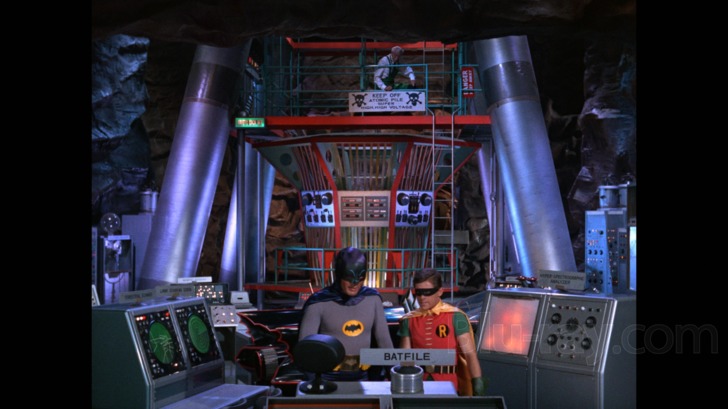
No review could cover all 120 episodes of Batman, and in any case the episode guide included with the complete set provides a good snapshot of each story, which, in the first two seasons, was split over two half-hour episodes (with a cliffhanger ending) and, in the third, often continued from week to week but without the cliffhanger ending, because the show was cut back to one episode per week. Still, Batman's plots followed such a consistent formula, and the show was such a unique phenomenon in the history of television, that one can talk about the episodes as a whole. The characters of Batman and Robin weren't the first heros from the world of DC Comics to be brought to the screen. The 1950s series Adventures of Superman starring George Reeves had been playing continuously in syndicated reruns for years by the time Batman debuted. But Batman was in eye-popping color, and it looked and sounded utterly different from anything else that had ever appeared on TV. One of the many reasons why Batman so quickly became "appointment TV" (in an era long before home video recording) was because viewers weren't entirely sure whether or not to take it seriously, even though, as star Adam West has repeatedly said, the people making it understood that it was a comedy. The word "camp" wasn't invented to describe Batman, but the show made the term part of the mainstream vocabulary, because the public needed a new and less familiar category for Batman. (West has repeatedly objected to calling Batman "camp", because he feels—rightly so—that the term has become dismissive.) Central to the show's appeal was West's slyly skillful portrayal of the dual rolls of the fabulously wealthy Bruce Wayne and his secret crime-fighting alter ego. Unlike the tortured souls who would become Batman's standard screen incarnations in the franchises later created by Tim Burton and Christopher Nolan, West's dual characters were paragons of well-adjusted normality, forever pausing to educate the impetuous Dick Grayson/Robin (played with flair by Burt Ward, whose chemistry with West was ideal) on matters of morality, deportment, civic virtue, basic hygiene, truth, justice and the American way. West's Batman not only walked the walk—frequently up a wall, using grappling hooks and Bat ropes, in an oft-repeated shot achieved by turning the camera sideways while West and Ward pretended to pull themselves along laboriously—but he also talked the talk. He educated his young listeners as well as Robin. And, as Bruce Wayne, he often did it with an avuncular smile. His and Dick's code word for disappearing down the Bat poles (each of them helpfully labeled with their names) was that they were "going fishing"—a nice, clean, wholesome, traditional activity that they used as a cover to fool Dick's clueless Aunt Harriet (Madge Blake) whenever they vanished to fight crime. But both West and series creator William Dozier (who served as the uncredited narrator whose closing phrase, "Same Bat time, same Bat channel!" remains familiar even today) were far too clever to make Batman just a two-dimensional model of rectitude. Without ever winking at the camera or departing from the scripted dialogue, West managed to infuse Batman with a sense of something just barely under control, as if all those elaborate lessons to Robin, which always elicited a response along the lines of, "Gosh, Batman, I guess you're right!", were as much for himself as for his young sidekick, an elaborate and ongoing patter needed to keep something in check and under control. Dozier and his writers retained Bruce Wayne's traditional back story of childhood loss, but it was West's performance that suggested the trauma had been buried so deeply that it now expressed itself in a kind of mania for normalcy and order that Batman's mask allowed Bruce Wayne to indulge to its fullest extent. West may not have used Christian Bale's growl or Michael Keaton's shyness, but he found his own way, within the comedic structure of Dozier's Batman, to express the Dark Knight's obsessive nature. The yin to Batman's yang were the villains, who arguably became more famous than the heroes themselves. Every episode of Batman featured a "guest villain", and a few special episodes had several. Popular villains returned repeatedly and developed their own fan bases, and several became iconic. Veteran actor Cesar Romero created a portrait of the Joker that continues to resonate, either as a model (for Jack Nicholson's portrayal in the 1989 Tim Burton film) or as something to avoid (as Heath Ledger clearly wanted to do in his Oscar- winning performance for Christopher Nolan). Burgess Meredith's incarnation of The Penguin has never been topped, including by Danny Devito in Batman Returns. Julie Newmar's Catwoman (in Seasons 1 and 2) gave indecent fantasies to many an adolescent boy, as did Eartha Kitt's (in Season 3); the latter was also a breakthrough performance for an African-American actress. Frank Gorshin's The Riddler (in Seasons 1 and 3) is still the gold standard for that character. And Mr. Freeze was played by three different actors—George Sanders, Eli Wallach and Otto Preminger—each of whom was more fun in the role than Arnold Schwarzenegger in Joel Schumacher's execrable Batman & Robin. (My apologies to fans of villains I have not mentioned, but there isn't room to cover them all.) Whatever their specific caper, the villains did what Batman and Robin couldn't. They luxuriated in living outside the laws, rules and norms that Batman luxuriated in living within. Certainly their plans often involved the acquisition of wealth, but more often than not getting was more important than having, especially if there was a chance to eliminate the Dynamic Duo along the way. When Heath Ledger's Joker tells Batman that he wouldn't know what to do without him in The Dark Knight, he could be speaking for most of the Batman TV series' villains, whose very existence seemed to depend on their Dark Knight's continued ability, when called upon by Commissioner Gordon (Neil Hamilton) and Chief O'Hara (Stafford Repp), to maintain a civilized order for the criminals to attack. After all, what fun is anarchy if it fully succeeds? Without Batman as the resident stick-in-the-mud, each week's guest villain wouldn't be able to fully measure (and fully enjoy) the extent of his or her transgressions. In both its storytelling and its visual style, Batman was a show of huge contrasts, right down to the giant "Kapow!", "Thwack!" and "Oooff!" panels that punctuated its fight scenes, bridging the world of animation and live action and breaking the familiar editing rhythms of TV action scenes. The sound effects panels worked because they were funny and they weren't quite real, but you believed them anyway—especially if you were a kid pretending to be Batman or Robin. Of course, the danger with such an overnight success as Batman is creative exhaustion, and by the end of the second season, the signs were everywhere. The writers had fallen into a pattern of recycling the same setups and plots, and the public was wearying of the formula. The introduction of Yvonne Craig's Batgirl in Season 3 was too little, too late. Where Season 1, with its mid-season premiere, ran for 34 episodes, and Season 2 ran for 60, Season 3 was canceled after just 26. The craze was over, but the phenomenon lives on.
Batman: The Complete Series Blu-ray Movie, Video Quality 

Leaving aside the various omissions referenced in the introduction, for which Warner has announced a disc replacement program, the presentation of Batman's 120 episodes on these twelve 1080p AVC-encoded Blu-rays will be a revelation even for those who saw the show in its original broadcast. Although Batman was shot on 35mm film, its intended format was low-resolution NTSC broadcast video. Until this restoration by Warner Home Video, no one outside the original creators and Warner insiders has seen the show's costumes and production design with this kind of detail or with colors of such richness and intensity. The technology for such high-quality home video distribution simply didn't exist in the Sixties (or, for that matter, the rest of the 20th Century). The series' costumes and production design made extensive use of bright primary colors, which are gorgeously featured in their various shades throughout these Blu-ray presentations, whether it's the blues of Batman's costume, the red, green and yellow of Robin's, the very different green of the Riddler's costume, or the blue + red (= purple) favored by the Joker and also the Penguin. The detailed gadgetry in the Batcave (which, in this rendition, is always well lit) has never been so easily distinguishable, and the same is true for the many devices with which the Batmobile has been outfitted (all very clearly labeled). The villains' lairs and hideouts have their own detailed personality and gadgets, although some of them are less distinct because of optical effects used to create them (e.g., the hot and cold zones for George Sanders' Mr. Freeze or the duel role of Liberace as Chandell and Harry). The interiors of stately Wayne Manor are equally detailed but almost drab by comparison, which is no doubt the intended effect. Many episodes open with stock footage used as establishing shots, and these are of lesser quality, but, with an occasional exception, everything shot for the series has survived in excellent condition. As rumored prior to the Blu-rays' release, the discs have been authored with a high degree of compression, resulting in a bitrate just under 15 Mbps for each episode. This applies even on Disc 12, the third disc of Season 3, which contains only two episodes. While no obvious compression anomalies leapt out—possibly because of bit-budget savings from the black windowbox bars and from scenes involving closeups of characters engaged in conversation—one has to question why WHV continues to aim for such low rates after going to the trouble of performing a major restoration such as that required for Batman. Could the episodes have looked even better, as some have claimed? There's no way to know. They certainly look great now.
Batman: The Complete Series Blu-ray Movie, Audio Quality 
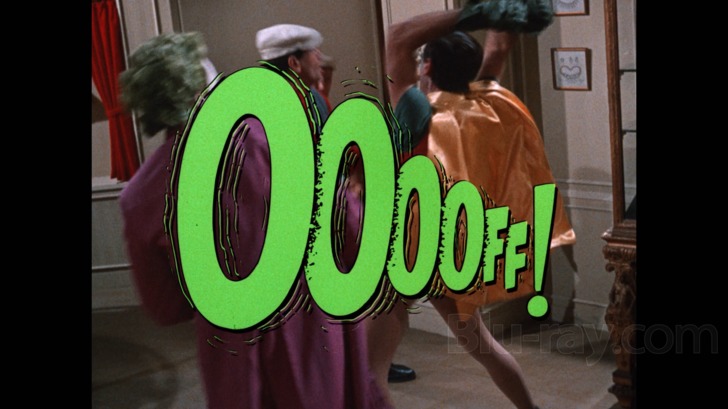
Let's start by acknowledging the obvious: Batman's 120 episodes have not been brought to Blu-ray with lossless sound. Instead they have lossy Dolby Digital 1.0 tracks (at 192 kbps). I do not know why Warner decided to go this route, and I am not going to speculate. The only question I want to address is, how does it sound? Pretty good, as it happens. First, a technical note. A bitrate of 192 kbps was the usual rate used for stereo soundtracks on DVD, and I never found those tracks particularly robust, especially when compared to their PCM counterparts on laserdisc. But when the full 192 kbps is devoted to a single channel, as it is here, the result is usually far superior. Criterion typically follows this practice with its mono DVDs, whereas most of the major studios split the available bits between two identical left and right channels, thereby weakening the presentation in both. Warner may have given us lossy sound for Batman, but at least they've done so in the best way possible for a mono soundtrack. Having been mixed for TV broadcast in the Sixties, Batman doesn't have the dynamic range one would expect from a current television show. Deep bass extension, for example, is almost non-existent, as are high trebles. The show's mix largely inhabits the mid-range, where its reproduction is remarkably good. Dialogue, voiceover narration, sound effects and the scoring by Nelson Riddle, Billy May and Warren Barker are crisp, clear and distinct, with no distracting interference or background noise. Most important of all, the signature Batman theme by Neil Hefti plays at the beginning and end of each episode with all the nostalgic urgency that long-time fans of the show could ever desire. A lossless treatment might add marginal improvement, but, given the age and nature of the original recording, probably very little (or none).
Batman: The Complete Series Blu-ray Movie, Special Features and Extras 
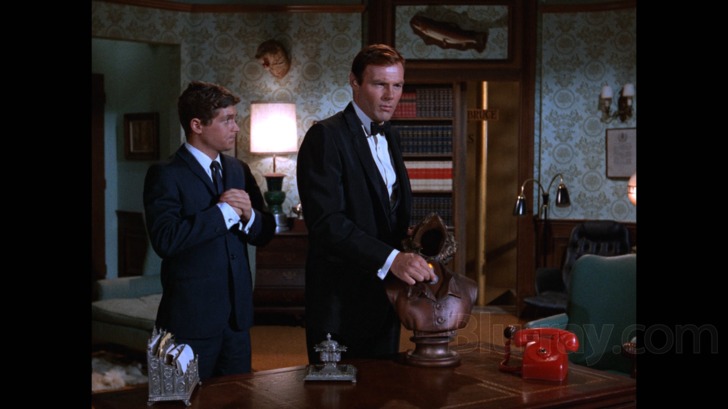
All of the disc-based extras are located on Disc 13.
- Hanging with Batman (1080p; 1.78:1; 29:56): This elegantly constructed portrait of Batman star Adam West combines a new 2014 interview with selections from previous interviews during various stages of West's career. The result is an informative, measured and often moving portrait of a man who went from a farm in Washington State to the height of stardom to which the TV series propelled him. Then he had to restart his career after agents and casting directors could no longer imagine him as anything but the Caped Crusader. A highlight is West's appearance, with Burt Ward and Julie Newmar, at 2014's ComicCon.
- Holy Memorabilia Batman! (1080p; 1.78:1; 29:59): The world of Batman memorabilia is rich and extensive, encompassing both the toys and action figures released during the show's original run, those manufactured in the decades after, original props and items from conventions and fan events. Collector Ralph Garman takes Adam West on a tour of his personal "cave" of collectibles, while Kevin Silva displays his official certification from the Guinness Book of World Records as the owner of the world's largest collection of Batman memorabilia. Also interviewed is Mark Racop, who custom-builds Batmobiles according to the show's original design.
- Batmania Born! Building the World of Batman (1080p; 1.78:1; 29:41): With the principal creators of the series' design no longer with us, this documentary celebrates their achievement by recounting its effect on young fans who have grown up to be creators in their own right: executives of DC Comics, producers of animated series for Warner, fashion designers for films and TV, etc. Burt Ward, Julie Newmar and Adam West also appear. (It's interesting that the only interviewee in the group who doesn't look perfectly normal is Andy Mangels, described as an "author and historian"; his beard and hairstyle look like something modeled on a Batman villain.) The presentation situates the show in the context of Sixties television and current events, and helps explain why the timing of the show's appearance contributed to its enormous popularity.
- Bats of the Round Table (1080p; 1.78:1; 45:08): In a variation on the IFC Channel's show Dinner for Five, a Batman-themed group gathers for dinner. The roster consists of Adam West, collector Ralph Garman (described here as a "radio personality"), filmmaker and comic book author Kevin Smith, actor Phil Morris (Smallville) and Jim Lee, co-publisher of DC Comics. The four fans take turns interviewing and admiring West, prompting him to share all manner of stories and recollections (including a juicy tale of how West persuaded the notoriously prickly Otto Preminger, playing Mr. Freeze, to cooperate with him during a fight scene). At the end, West pretends to be summoned away by an unseen Alfred for a mysterious emergency.
- Inventing Batman: In the Words of Adam West (1080p; 1.78:1): The two-part pilot plays with occasional interruptions and commentary by West, as he consults his notes on the original script.
- Hi Diddle Riddle (29:30)
- Smack in the Middle (29:39)
- Na Na Na Batman! (1080p; 1.78:1; 12:15): The least substantive of the extras tries to convey a sense of the excitement that the show created in the younger audience by interviewing a cross-section of fans drawn primarily from actors on various contemporary TV shows. Big surprise! They're Warner shows like Arrow and The Following. A veneer of genuine fandom is cast over the whole enterprise by the occasional appearance of someone knowledgeable such as Mike Carlin, Creative Director of Animation at DC Comics (who also appears in "Batmania Born!").
- Bat Rarities! Straight from the Vault
- Batgirl Pilot (1080p; 1.33:1; 7:54): A brief introduction to the Barbara Gordon character.
- Burt Ward Screen Test with Adam West (1080p; 1.33:1; 6:16): During the "Round Table" discussion, West says that he could tell within twenty seconds that Ward was the right actor for the part.
- Actors Screen Tests: Lyle Waggoner and Peter Deyell (1080p; 1.33:1; 4:23): Have you ever imagined an alternate universe where Batman and Robin were played by actors other than West and Ward? This screen test suggests the possibilities.
- James Blakeley Tribute (1080p; 1.33:1; 2:24): Blakeley was the post-production supervisor for Batman and also edited several episodes, as he describes in this interview clip.
- Books, Swag and Memorabilia
- Hot Wheels® Replica Batmobile
- 44 Vintage Trading Cards
- The Adam West Scrap Book (hardcover)
- Episode Guide (including a letter to fans from Adam West)
- Ultraviolet Digital Copy
Batman: The Complete Series Blu-ray Movie, Overall Score and Recommendation 
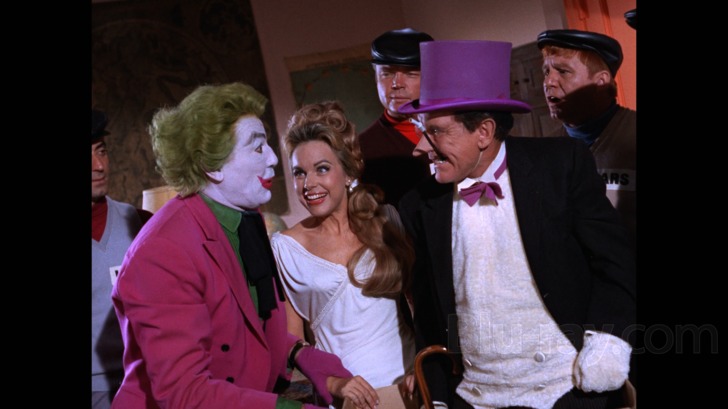
Over the years, many fictional creations have been proclaimed as "our" national mythology, including the Star Wars universe, one or more portions of the Marvel Comics world, Superman in his many guises and, of course, Batman. There doesn't need to be competition among these. As the ancient Greeks demonstrated, popular mythology has room for many heros. They serve different purposes a different times, and their character and quality resonate to a greater or lesser extent, depending on what the culture needs at a particular moment. Batman has always been unique, however, because he is an ordinary person behind his various masks, both the literal one that hides his identity as Bruce Wayne and the figurative mask of wealth and privilege that shields Bruce Wayne from the rest of the world and allows him the freedom to lead two lives. Because Batman has no special powers, he can act out emotions and fantasies that everyone understands, but on a much larger canvas, which is why he remains one of the most "relatable" of superheroes (to use an industry cliche). How a storyteller chooses to use that relatability says a lot about both the storyteller and the age in which he is writing. Lorenzo Semple Jr., the writer who created the template for Batman, used humor and wit to submerge the essential darkness of the Batman character as subtext. Semple was writing for a more idealistic and hopeful era, which is why he and his collaborators were able to create a beautifully self-contained world of primary colors and essential virtues, where good always triumphed. That world is still as lovely as Oz, and (errors and omission excepted) its Blu-ray presentation is highly recommended.
Other editions
Batman: Other Seasons

Batman: The Complete Classic Batman Collection
1966-1968

Batman: The Complete Series
Standard Edition
1966-1968

Batman: The Complete Television Series
1966-1968

Batman: The Complete Television Series
1966-1968
Similar titles
Similar titles you might also like

Batman: The Movie
Special Edition
1966

Batman: Return of the Caped Crusaders
2016

Peacemaker: The Complete First Season
2022

Agent Carter: The Complete First Season
2015

Birds of Prey (And the Fantabulous Emancipation of One Harley Quinn)
2020

The Green Hornet
2011

The Boys: Season 4
2024

Kingsman: The Golden Circle
2017

Tamara Drewe
2010

The Amazing Spider-Man 2
2014

The Amazing Spider-Man
2012

Adventures of Captain Marvel
1941

Daredevil: The Complete First Season
2015

The Phantom
2009

Wonder Woman 1984 4K
2020

Batwoman: The Third and Final Season
2021-2022

Wonder Woman 4K
2017

Captain Marvel 4K
Cinematic Universe Edition
2019

Nick Fury: Agent Of Shield
1998

Suicide Squad
Theatrical & Extended Cut
2016